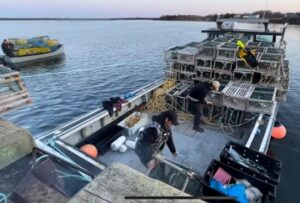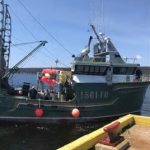Tag Archives: Minas Passage

Nova Scotia calls tender for Fundy tidal power site
The energy is there and so is the wire. All you need to do is catch it and put it in the wire and the province will guarantee you a subsidized rate for 15 years. But there’s two big caveats on the offer. First you have clean up the mess left by the last company that tried. The province is requiring any responders to a call for tenders to take over Berth D at the Fundy Ocean Research Centre for Energy pony up a $4.5 million security for the removal of the 1,300-tonne turbine abandoned at the site. Another caveat is that you have to figure out how to get the energy out of the water hauled through the Minas Passage by the tide. So far no one has been successful. And finally you need to find someone to lend you money to build this machine. >click to read< 09:52
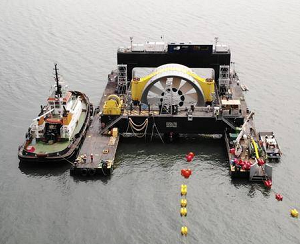
Legal fight over Open Hydro continues
Local businesses left holding the bag for millions of dollars worth of work installing a tidal turbine in the Minas Passage want the Irish parent company to keep its hands off its bankrupt subsidiary’s remaining asset.,, The company was the Canadian subsidiary of Irish parent OpenHydro that went bankrupt days after a massive tidal turbine was installed in the Minas Passage. The Irish company’s bankruptcy occured after French defence firm Naval Energies, which had been bankrolling the project to the tune of hundreds of millions of dollars, pulled its funding. >click to read< 12:37

EDITORIAL: Tidal turbines’ troubled waters
For decades, politicians and provincial boosters have been touting the potential of Nova Scotia’s tidal power. We’re steeped in tide lore around here, from the Shubenacadie River’s tidal bore to those time-lapse videos of dockside fishing boats being floated off the bottom by the incoming tide. There’s enormous power in the Bay of Fundy, if only some clever engineer could channel it somehow into our energy grid. It’s clean, it’s renewable and it’s free. Well, it’s proving more complicated, expensive and difficult to harness that energy than even the most skeptical observer could have imagined. And an accident involving a fishing boat is just more bad news for efforts to use the tides to wean ourselves from coal-burning electricity generation. >click to read<13:15

Clock ticking on Bay of Fundy tidal turbine removal
Meanwhile fishermen who work along the Minas Passage want the turbine out of the water. – OpenHydro Technologies Canada Ltd. has a month to find someone who wants to pay to lift a broken 1,300-tonne turbine out of the Minas Passage. Once the stay of proceedings granted Wednesday by Nova Scotia Supreme Court Justice Michael Wood expires in December, OpenHydro’s creditors can swoop in. They won’t find much – according to court filings the company only has two major assets. >click to read<16:42

Big dreams for tidal power: Irish company hoping to drop turbines in Minas Passage, expecting some cynicism
Simon De Pietro will have to mend burnt bridges before he can build the world’s largest tidal array. “I expect there to be some cynicism and it’s not a good thing that happened,” said the director of DP Energy, based in Ireland. “But that wasn’t us.” His company’s plan to install an array of five sub-sea tidal turbines and one floating turbine in the Minas Passage with a combined power output of nine megawatts makes him the latest Irish proponent with big dreams for tidal power. The last one was OpenHydro, which went bankrupt days after installing its turbine on July 22 — leaving local companies holding the bag for millions of dollars worth of work and a 1,000-tonne turbine on the seabed. A team brought from Ireland to get it working over recent weeks have determined that it’s not spinning as a result of an unknown mechanical failure. >click to read<
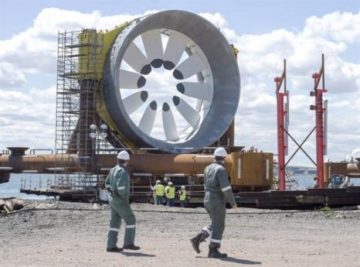
Ownerless Bay of Fundy turbine operating without fish kill monitoring gear
Even before Cape Sharp Tidal, owned by Irish company OpenHydro and Emera, placed it on the floor of the Minas Passage two weeks ago and OpenHydro was placed in receivership days later, the 10-billion tonnes of seawater hauled into the narrowing between Cape Split and Cape Chignecto was already tainted by bad blood. “The opposition isn’t about just whether it kills fish because other things kill fish too — fishermen kill fish,” said Mary McPhee, former facilities operator for the Fundy Ocean Research Centre for Energy, the government-funded tidal test site commonly known as FORCE. “What fishermen want is for the tidal power people to be treated in the same manner as they are. They want the law to be applied equally. So if a fishery has a quota, why can’t tidal power have a quota?” >click to read<08:47
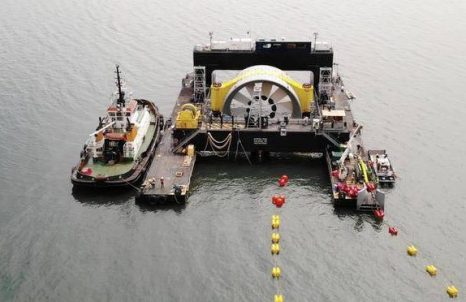
“That turbine was put down there in bad faith.” – Cape Sharp Tidal owner files for bankruptcy in Ireland
A week after a massive tidal turbine was placed in the Minas Passage, its owners have filed for bankruptcy. Local contractors, marine service companies, motels, fishermen and other business people are owed an undetermined amount of money. OpenHydro owns 97 per cent of Cape Sharp Tidal, with the remaining three percent owned by Emera, Nova Scotia Power’s parent company.,, Fishermen claim they were told the turbine would not be installed at the Force site in the Minas Passage until the close of the lobster season at the end of July. “They used all these local resources, hired all these local business people, drove right over all that local lobster gear and they never intended to pay nobody,” said Darren Porter, spokesman for the Fundy United Federation, a fishermen’s organization. One contractor, who didn’t want his named used, estimated that OneHydro owes “tens of millions of dollars” to local companies. >click to read<22:11
Cape Sharp Tidal turbine removed from water – Fishermen, “For us, it’s a total vindication,,,”
 The Cape Sharp Tidal turbine has been removed from the Minas Passage, but plans to conduct testing at another location farther down the Nova Scotia coast have been cancelled. The company had planned to move the turbine in April from near Parrsboro to St. Marys Bay to do some short-term hydrodynamic testing. But a mooring line became entangled in it, so the move was postponed. Cape Sharp spokesperson Stacey Pineau said the company now has no plans to resume the testing in St. Marys Bay. The proposed testing had drawn opposition from some fishermen, who said no environmental assessment had been carried out for that work. Colin Sproul, of the Bay of Fundy Inshore Fishermen’s Association, said the removal of the turbine is “a positive development” because the company has not been able to monitor the equipment since the turbine was disconnected from the transmission cable two months ago. click here to read the story 18:52
The Cape Sharp Tidal turbine has been removed from the Minas Passage, but plans to conduct testing at another location farther down the Nova Scotia coast have been cancelled. The company had planned to move the turbine in April from near Parrsboro to St. Marys Bay to do some short-term hydrodynamic testing. But a mooring line became entangled in it, so the move was postponed. Cape Sharp spokesperson Stacey Pineau said the company now has no plans to resume the testing in St. Marys Bay. The proposed testing had drawn opposition from some fishermen, who said no environmental assessment had been carried out for that work. Colin Sproul, of the Bay of Fundy Inshore Fishermen’s Association, said the removal of the turbine is “a positive development” because the company has not been able to monitor the equipment since the turbine was disconnected from the transmission cable two months ago. click here to read the story 18:52
Proposal to move Bay of Fundy tidal turbine raises fishermen’s concerns
 A fishermen’s group in the Bay of Fundy is worried about Cape Sharp Tidal Venture’s plan to temporarily move its tidal turbine from a designated testing area to a site where an environmental assessment has not been carried out. The Bay of Fundy Inshore Fishermen’s Association said the move endangers fish and violates the rules governing the development of tidal energy in the area. The Cape Sharp Tidal Venture turbine is a joint project between Emera Inc. and OpenHydro. The turbine is currently in the Minas Passage near Parrsboro, N.S. Cape Sharp Tidal confirms that work is currently underway to remove the turbine. It wants to bring it to another area in the Bay of Fundy to do operational tests that would run about five days. “They have no approval to conduct that testing and more importantly is there will be no environmental-monitoring equipment at the site,” said Colin Sproul, spokesperson for the Bay of Fundy Inshore Fishermen’s Association. click here to read the story 20:15
A fishermen’s group in the Bay of Fundy is worried about Cape Sharp Tidal Venture’s plan to temporarily move its tidal turbine from a designated testing area to a site where an environmental assessment has not been carried out. The Bay of Fundy Inshore Fishermen’s Association said the move endangers fish and violates the rules governing the development of tidal energy in the area. The Cape Sharp Tidal Venture turbine is a joint project between Emera Inc. and OpenHydro. The turbine is currently in the Minas Passage near Parrsboro, N.S. Cape Sharp Tidal confirms that work is currently underway to remove the turbine. It wants to bring it to another area in the Bay of Fundy to do operational tests that would run about five days. “They have no approval to conduct that testing and more importantly is there will be no environmental-monitoring equipment at the site,” said Colin Sproul, spokesperson for the Bay of Fundy Inshore Fishermen’s Association. click here to read the story 20:15
Fishermen skeptical of third environmental monitoring device in the Minas Passage
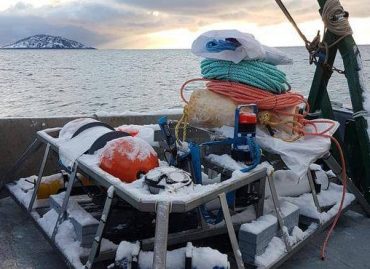 A third environmental monitoring platform is being tested in the Minas Passage by the Fundy Ocean Research Centre for Energy, or FORCE, but a fishermen’s group maintains the sophisticated equipment being deployed still cannot determine mortality, the ultimate environmental test on marine life in the Bay of Fundy. FAST-3 is a third monitoring platform featuring additional sensors to collect data on fish presence and behaviour that was deployed on Feb 2. Several marine industrial companies around the province contributed to its construction and deployment. The platform isn’t on the actual turbine site but in a 10-metre shallower area adjacent to the Crown-lease area that the Province of Nova Scotia has designated for testing up to five different turbine technologies in the near future. Dr. Haley Viehman, a post-doctoral fellow at Acadia University, will be analyzing the data upon its retrieval within a month. Viehman comes to the province from the University of Maine, where she studied fish interactions for five years using hydro-acoustics to observe fish movements prior, during and after a tidal turbine was deployed in 2012 for a year as a test in Cobscook Bay, Maine. Continue reading the story here 12:31
A third environmental monitoring platform is being tested in the Minas Passage by the Fundy Ocean Research Centre for Energy, or FORCE, but a fishermen’s group maintains the sophisticated equipment being deployed still cannot determine mortality, the ultimate environmental test on marine life in the Bay of Fundy. FAST-3 is a third monitoring platform featuring additional sensors to collect data on fish presence and behaviour that was deployed on Feb 2. Several marine industrial companies around the province contributed to its construction and deployment. The platform isn’t on the actual turbine site but in a 10-metre shallower area adjacent to the Crown-lease area that the Province of Nova Scotia has designated for testing up to five different turbine technologies in the near future. Dr. Haley Viehman, a post-doctoral fellow at Acadia University, will be analyzing the data upon its retrieval within a month. Viehman comes to the province from the University of Maine, where she studied fish interactions for five years using hydro-acoustics to observe fish movements prior, during and after a tidal turbine was deployed in 2012 for a year as a test in Cobscook Bay, Maine. Continue reading the story here 12:31

Protesters hope to change course of tidal project
Energy Minister Michel Samson, Emera representatives and members of FORCE weren’t the only ones to go to Parrsboro on Tuesday to witness flicking the switch to turn on an in-stream tidal power turbine. A group of 20 people, including fisherman, Mi’kmaw, scientists and community members protested on the West Bay Road on the way to the FORCE site. They blocked one side of the road with a tree so everyone attending the event would have to drive it and see them. Local RCMP were called but didn’t disband the group or ask them to leave. “We were peaceful but wanted to put our point across that we still do not consent to this,” said weir fisherman Gerry Taylor. Taylor fishes out of Parrsboro and his weir is closest to the FORCE site. He has a wife, four children and staff who rely on him. He’s also the president of the Fundy United Federation, representing fishers and driftnetters in the Minas Passage and Minas Basin. Read the story here 11:04
Cape Sharp Tidal installs first of two 2MW turbines in Minas Passage
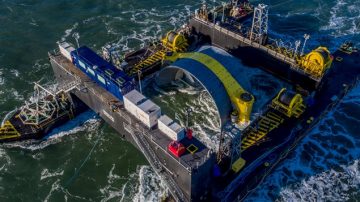 Several months after receiving approval from Nova Scotia’s Department of Environment to deploy two 16-metre, 1,000 tonne turbines in the Bay of Fundy’s Minas Passage, Cape Sharp Tidal has finally submerged the first of the OpenHydro Open-Centre 2MW turbines at the Fundy Ocean Research Centre for Energy (FORCE), near Parrsboro. Cape Sharp Tidal plans to connect the turbine to the power grid in the coming days via FORCE’s subsea cable, which during the next several weeks will deliver Nova Scotia’s first in-stream tidal energy to the province’s power grid. The turbine was towed on a barge from West Bay to the FORCE site on Monday morning, and then lowered to the sea floor in a four-hour operation during an ebb tide. The deployment follows months of delay for environmental review and an injunction request filed by the Bay of Fundy Inshore Fishermen’s Association, challenging the approval of Nova Scotia’s Environment Minister over concerns regarding the project’s possible impacts on sealife. Read the story here 18:24
Several months after receiving approval from Nova Scotia’s Department of Environment to deploy two 16-metre, 1,000 tonne turbines in the Bay of Fundy’s Minas Passage, Cape Sharp Tidal has finally submerged the first of the OpenHydro Open-Centre 2MW turbines at the Fundy Ocean Research Centre for Energy (FORCE), near Parrsboro. Cape Sharp Tidal plans to connect the turbine to the power grid in the coming days via FORCE’s subsea cable, which during the next several weeks will deliver Nova Scotia’s first in-stream tidal energy to the province’s power grid. The turbine was towed on a barge from West Bay to the FORCE site on Monday morning, and then lowered to the sea floor in a four-hour operation during an ebb tide. The deployment follows months of delay for environmental review and an injunction request filed by the Bay of Fundy Inshore Fishermen’s Association, challenging the approval of Nova Scotia’s Environment Minister over concerns regarding the project’s possible impacts on sealife. Read the story here 18:24
After months of outcry from fishermen, Cape Sharp Tidal prepares to deploy Bay of Fundy turbine
 After months of outcry from fishermen, a tidal power company has started preparations to deploy an energy-generating turbine in the Minas Basin near Parrsborro, N.S. The company has a week long window to install the turbine. On Saturday, Cape Sharp Tidal Ventures started launching the first of two planned turbines, intended to generate power from water passing through the Bay of Fundy inlet. The first was moved from Saint John to Parrsborro Friday night. By Saturday afternoon, the turbine was on its subsea base, and was waiting to be moved into the basin Passage by a barge and tugboat, the company said by email. It’s unclear when the installation will be finished, but the crews can only work on it during twice-daily slack tides. The project has been met with opposition led by the Bay of Fundy Inshore Fishermen’s Association. The group believes the five-storey turbines will cause irreparable harm to marine life and fisheries. “We’re extremely disappointed that the chance to get our accurate baseline science in the Minas Passage is forever lost in Nova Scotia,” association spokesman Colin Sproul said Saturday. Read the rest here 9:48
After months of outcry from fishermen, a tidal power company has started preparations to deploy an energy-generating turbine in the Minas Basin near Parrsborro, N.S. The company has a week long window to install the turbine. On Saturday, Cape Sharp Tidal Ventures started launching the first of two planned turbines, intended to generate power from water passing through the Bay of Fundy inlet. The first was moved from Saint John to Parrsborro Friday night. By Saturday afternoon, the turbine was on its subsea base, and was waiting to be moved into the basin Passage by a barge and tugboat, the company said by email. It’s unclear when the installation will be finished, but the crews can only work on it during twice-daily slack tides. The project has been met with opposition led by the Bay of Fundy Inshore Fishermen’s Association. The group believes the five-storey turbines will cause irreparable harm to marine life and fisheries. “We’re extremely disappointed that the chance to get our accurate baseline science in the Minas Passage is forever lost in Nova Scotia,” association spokesman Colin Sproul said Saturday. Read the rest here 9:48
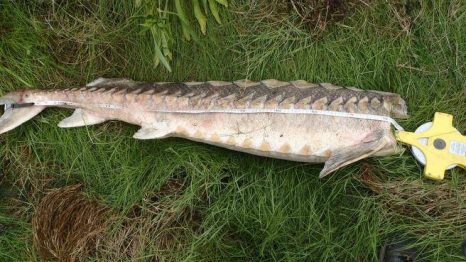
New turbines just as lethal as Annapolis turbines
Much more needs to be said and written about the testing of tidal stream turbines in Minas Passage. Graham Daborn, emeritus professor at Acadia University, wrote an Opinions article under this heading (Oct. 15), but without the “more”. Unfortunately much of what has been said and written comes from the proponents of tidal power. And they have obscured the facts about what the physical properties of their machines can do to living organisms. People living around Minas Basin still talk about what happened when the first turbine was installed at the FORCE (Fundy Ocean Research Center for Energy) experimental site in 2009. Two humpback whales suddenly showed up on Minas Basin beaches with large gashes in their bodies. That turbine suddenly stopped working and when it was lifted in 2010 blades were broken. What broke them? Annapolis was installed as a test turbine and 31 years later it is still spinning, still killing fish (five sturgeon and counting this year). There never was an environmental assessment. Read the op-ed here 09:43
Bay of Fundy tidal energy battle heads to court Thursday
 The Nova Scotia government and a company attempting to deploy two tidal turbines in the Bay of Fundy have joined forces to fight a move by a fishermen’s association to block the venture. The Bay of Fundy Inshore Fishermen’s Association is scheduled to appear Thursday in Nova Scotia Supreme Court to ask for a stay on an approval that will allow Cape Sharp Tidal Ventures to install two 16-metre-wide turbines at the bottom of the Minas Passage. Cape Sharp Tidal is a partnership between Halifax-based Emera, parent company of Nova Scotia Power, and French-owned Open Hydro. The province and Cape Sharp Tidal want the court to dismiss the application. Read the story here 09:57
The Nova Scotia government and a company attempting to deploy two tidal turbines in the Bay of Fundy have joined forces to fight a move by a fishermen’s association to block the venture. The Bay of Fundy Inshore Fishermen’s Association is scheduled to appear Thursday in Nova Scotia Supreme Court to ask for a stay on an approval that will allow Cape Sharp Tidal Ventures to install two 16-metre-wide turbines at the bottom of the Minas Passage. Cape Sharp Tidal is a partnership between Halifax-based Emera, parent company of Nova Scotia Power, and French-owned Open Hydro. The province and Cape Sharp Tidal want the court to dismiss the application. Read the story here 09:57
OPINION: Tidal power from Fundy — Separating fact from fiction, Graham Daborn Emeritus Professor at Acadia University
There have been a number of statements in the media over the last few months about the testing of in Minas Passage. Regrettably, inaccurate and exaggerated claims have led to a good deal of public apprehension and confusion. It only takes a few seconds to make an inaccurate or ridiculous statement. Explaining why a statement is untrue or ridiculous, unfortunately, takes rather more time or space. The following addresses a few of these issues. Claim 1: That the turbines to be installed at FORCE will “chop whales into sushi for seabirds to eat.” In response to a question during a CBC interview (on The Current, June 15), a spokesperson for the Bay of Fundy Inshore Fisherman’s Association said: “This is not a suggestion; it is a fact.”,,, The only way to determine that is to install a turbine with monitoring equipment in place to establish the animals’ responses. At present, there is absolutely no evidence that mammals would be at risk of death or injury from the turbines to be tested in Minas Passage, although they may end up having to forage elsewhere. Read the op-ed here, and keep up the fight! 10:55
in Minas Passage. Regrettably, inaccurate and exaggerated claims have led to a good deal of public apprehension and confusion. It only takes a few seconds to make an inaccurate or ridiculous statement. Explaining why a statement is untrue or ridiculous, unfortunately, takes rather more time or space. The following addresses a few of these issues. Claim 1: That the turbines to be installed at FORCE will “chop whales into sushi for seabirds to eat.” In response to a question during a CBC interview (on The Current, June 15), a spokesperson for the Bay of Fundy Inshore Fisherman’s Association said: “This is not a suggestion; it is a fact.”,,, The only way to determine that is to install a turbine with monitoring equipment in place to establish the animals’ responses. At present, there is absolutely no evidence that mammals would be at risk of death or injury from the turbines to be tested in Minas Passage, although they may end up having to forage elsewhere. Read the op-ed here, and keep up the fight! 10:55
Meanwhile in the Bay of Fundy, Nova Scotia government approves “experimental” turbine deployment
 The Nova Scotia government has approved a plan to deploy two experimental tidal turbines in the Minas Passage for research purposes. The government announced the approval of the proposed monitoring program for the Fundy Ocean Research Center for Energy (FORCE) and Cape Sharp Tidal Venture in a news release on Monday. The turbines, which are each 16 metres in diameter and weigh 1,000 tonnes, were originally scheduled for deployment last year, but were delayed by weather. Fishermen and environmental groups have raised concerns that the giant turbines would have a negative impact on marine life in the Bay of Fundy. Environment Minister Margaret Miller said in a news release that the full environmental impact of the project will not be known until the turbines are in the water. Read the rest here 11:34
The Nova Scotia government has approved a plan to deploy two experimental tidal turbines in the Minas Passage for research purposes. The government announced the approval of the proposed monitoring program for the Fundy Ocean Research Center for Energy (FORCE) and Cape Sharp Tidal Venture in a news release on Monday. The turbines, which are each 16 metres in diameter and weigh 1,000 tonnes, were originally scheduled for deployment last year, but were delayed by weather. Fishermen and environmental groups have raised concerns that the giant turbines would have a negative impact on marine life in the Bay of Fundy. Environment Minister Margaret Miller said in a news release that the full environmental impact of the project will not be known until the turbines are in the water. Read the rest here 11:34

































